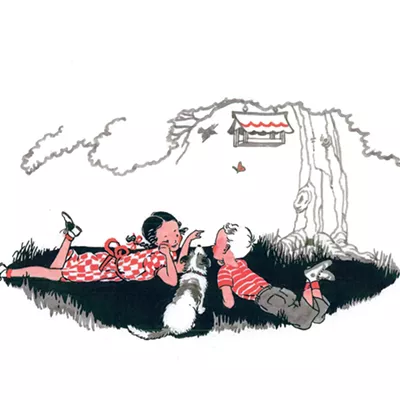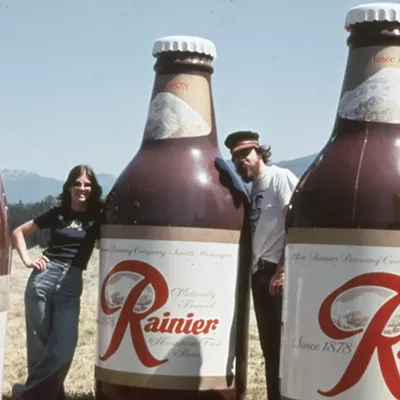The construction of Grand Coulee Dam was revolutionary.
So revolutionary, in fact, people traveled to Eastern Washington in hordes just to catch a glimpse, to work on it themselves, and to be a part of the most significant public works project in history (up until that point).
Even though it brought low-cost electricity to the Northwest, Grand Coulee Dam's construction was quite controversial at the time due to its location and ultimate purpose, and its impacts on people and the environment.
In her recently published novel The Grand Promise, Seattle-based author Rebekah Anderson highlights the oft-forgotten cost of the dam's construction through interwoven storylines of tense child-parent relationships, moral dilemmas and people's response to change. During two upcoming events at Spokane Public Library branches on June 7 and 8, Anderson is set to discuss the research that went into writing The Grand Promise.
When construction began on the dam in 1933, Anderson's grandparents resided in a small town about 100 miles north of the dam's future site, fairly close to the Canadian border.
"I went on a road trip with my mom to see the house that my grandfather was born in several years ago," Anderson says. "And she was telling me that the town where his school was, was no longer there."
"I asked her why it isn't there anymore and she told me that the town is literally under Lake Roosevelt," she says. "And that's what got me interested in this because the dam isn't even that close. It's not exactly in the neighborhood."
As the road trip progressed, Anderson began to wonder how many people still know about the Grand Coulee Dam's history and the displacement it caused. From then, she became determined to preserve the stories of the people who lived through it, with her own grandparents' lives serving as the catalyst for the story.
The Grand Promise begins with a heated town meeting as a representative from the U.S. Bureau of Reclamation informs the citizens of Kettle Rapids that a dam is to be built on the Columbia River, just south of their homes.
Good news: The dam will provide irrigation to 10,000 square miles of farmland east of the Cascades and pay back construction costs in less than 50 years.
Bad news: The town of Kettle Rapids will soon be underwater as a result of damming the Columbia River along with other towns situated on offshoots of the Columbia.
Outraged, its residents yell out a flurry of questions. How much will they be paid to relocate? When will they have to leave? What about the lives they've worked so hard to build?
As things become heated between the residents and Bureau representatives, so do familial relationships.
Carter Price, the novel's protagonist, hasn't had an easy life. His wife wants a divorce. His father belittles him endlessly. He's had enough and decides to flee Kettle Rapids for a fresh start. He ends up at the dam site, working for the very people his father despises.
As The Grand Promise progresses, readers encounter characters from all walks of life who are equally invested in the construction of the dam, each for very different reasons.
Carter's Native American co-worker Joe Mainzer works on the construction crew despite knowing his people's lands are soon to be destroyed.
Grand Coulee's construction caused flooding of lands traditionally held by the Spokane Tribe of Indians and the Confederated Tribes of the Colville Reservation. The flooding also wiped away the salmon population that had sustained the region's Indigenous population, along with spiritual practices surrounding salmon and the river.
Along with ensuring character accuracy, Anderson wanted to make sure she had her geography down pat.
"I spent a lot of time in Kettle Falls, of course, but also in Colville, Wenatchee, Ephrata and at Fort Spokane," she says. "I made frequent trips out there and took a lot of notes about landscape and where it changes because Carter is walking for a decent portion of the book."
"I also spent a lot of time looking at old photos because a lot of the buildings that I talk about aren't there anymore due to flooding and time."
The Grand Promise comes to a head in 1937 when President Franklin D. Roosevelt visits the dam site. He's met with a roaring crowd full of supporters as well as protesters.
"As I wrote the story I wanted to take a deliberately neutral position through the writing," Anderson says. "Part of the conflict of the story is that there are two sides to this and it's not a straightforward good or bad evaluation."
Though the reader never learns exactly what happens to the novel's characters after the dam's completion on June 1, 1942, Anderson says that's intentional.
"The whole story, you read about the pros and cons of the dam," she says. "The characters must learn to live with the upsides as well as the downsides. That's just how life goes." ♦
Rebekah Anderson & Shawn Vestal • Wed, June 7 from 6:30-7:30 pm • Free • Liberty Park Library • 502 S. Pittsburg St.
Inland Northwest Special Collections Writing Tour • Thu, June 8 from 11 am-noon • Free • Central Library • 808 W. Main Ave. • Event details at spokanelibrary.org























